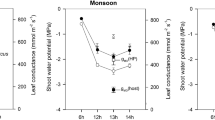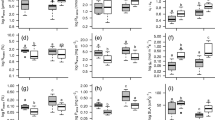Summary
The gas exchange and water relations of the hemiparasite Pthirusa maritima and two its mangrove host species, Conocarpus erectus and Coccoloba uvifera, were studied in an intertidal zone of the Venezuelan coast. Carbon uptake and transpiration, leaf osmotic and total water potential, as well as nutrient content in the xylem sap and leaves of mistletoes and hosts were followed through the dry and wet season. In addition, carbon isotope ratios of leaf tissue were measured to further evaluate water use efficiency. Under similar light and humidity conditions, mistletoes had higher transpiration rates, lower leaf water potentials, and lower water use efficiencies than their hosts. Potassium content was much higher in mistletoes than in host leaves, but mineral nutrient content in the xylem sap of mistletoes was relatively low. The resistance of the liquid pathway from the soil to the leaf surface of mistletoes was larger than the total liquid flow resistance of host plants. Differences in the daily cycles of osmotic potential of the xylem sap also indicate the existence of a high resistance pathway along the vascular connection between the parasite pathway along the vascular connection between the parasite and its host. P. maritima mistletoes adjust to the different physiological characteristics of the host species which it parasitizes, thus ensuring an adequate water and carbon balance.
Similar content being viewed by others
References
Allen SE, Grimshaw HM, Parkinson JA, Quarmby C (1974) Chemical Analysis of Ecological Materials. Blackwell Scientific Publications, Oxford, p 565
Biddulph O, Nakayama FS, Cory R (1961) Transpiration stream and ascension of calcium. Plant Physiol 36:429–436
Bradford KJ, Sharkey TD, Farquhar GD (1983) Gas exchange, stomatal behavior and C values of the flaca tomato mutant in relation to abscisic acid. Plant Physiol 72:245–258
Caemmerer S von, Farquhar GD (1981) Some relationships between the biochemistry of photosynthesis and the gas exchange of leaves. Planta 153:376–387
Clough DF, Andrews TJ, Cowan IR (1982) Physiological processes in mangroves. In: BF Clough (ed) Mangroves Ecosystems in Australia. Austr Nat Univ Press, pp 193–210
Downton WJS, Grant WJR, Robinson SP (1985) Photosynthetic and stomatal response of spinach leaves to salt stress. Plant Physiol 78:85–88
Ehleringer JR, Schulze E-D, Ziegler H, Lange OL, Farquhar GD, Cowan IR (1985) Xylem mistletoes: water or nutrient parasites? Science 227:1479–1481
Ehleringer JR, Cook CS, Tieszen LL (1986) Comparative water use and nitrogen relationships in a mistletoe and its host. Oecologia 68:279–284
Evans JR, Sharkey TD, Berry JA, Farquhar GD (1986) Carbon isotope discrimination measured concurrently with gas exchange to investigate CO2 diffusion in leaves of higher plants. Austr J Plant Physiol 13:281–292
Farquhar GD, O'Leary MH, Berry JA (1982) On the relationship between carbon isotope discrimination and intercellular carbon dioxide concentration in leaves. Austr J Plant Physiol 9:121–137
Francey RJ, Gifford RM, Sharkey TD, Weir B (1985) Physiological influences on carbon isotope discrimination in huon pine (Lagarostrobos franklinii). Oecologia 66:211–218
Glatzel G (1983) Mineral nutrition and water relations of hemiparasitic mistletoes: a question of partitioning. Experiments with Loranthus europaeus on Quercus petraea and Quercus robur. Oecologia 58:310–321
Hamze M (1985) Xylem sap extraction from citrus seedlings using a modified pressure chamber method. J Plant Nutr 8(3):219–232
Hawksworth FG (1983) Mistletoes as forest parasites. In: M Calder, P Bernhardt (eds) The Biology of Mistletoes. Academic Press, New York, pp 185–204
Hollinger DY (1983) Photosynthesis and water relations of the mistletoe, Phoradendron villosum, and its host, the California valley oak, Quercus lobata. Oecologia 60:396–400
Horwitz W (1980) Official Methods of Analysis of the Association of Official Analytical Chemists. 13th Edit., Association of Official Analytical Chemists., Washington
Jarvis PG (1975) Water transport in plants. In: DA deVries, HH Afgan (eds) Heat and Mass Transfer in the Biosphere. John Wiley and Sons, New York, pp 369–394
Lamont BB (1983) Minerals nutrition of mistletoes. In: M Calder, P Bernhardt (eds) The Biology of Mistletoes. Academic Press, New York, pp 185–204
Roeske CA, O'Leary MH (1984) Carbon isotope effects on the enzyme-catalized carboxylation of ribulose bisphosphate. Biochemistry 23:6275–6284
Scholander PF, Bradstree ED, Hammel HT, Hemmingsen EA (1966) Sap concentrations in halophytes and some other plants. Plant Physiol 41:529–532
Schulze E-D, Ehleringer JR (1984) The effect of nitrogen supply on growth and water-use efficiency of xylem-tapping mistletoes. Planta 162:268–275
Schulze E-D, Turner NC, Glatzel G (1984) Carbon, water and nutrient relations of two mistletoes and their hosts: a hypothesis. Plant, Cell Environm 7:293–299
Tomlinson PB (1986) The botany of mangroves. Cambridge University Press, Cambridge, p 413
Ulrich A (1952) Physiological bases for assessing the nutritional requirements of plants. Ann Rev Plant Physiol 3:207–228
Ullmann I, Lange OL, Ziegler H, Ehleringer JR, Schulze E-D, Cowan IR (1985) Diurnal courses of leaf conductance and transpiration of mistletoes and their hosts in Central Australia. Oecologia 67:577–587
Weisel Y, Eshel A, Agami M (1986) Salt balance of leaves of the mangrove Avicennia marina. Physiol Plant 67:67–72
Author information
Authors and Affiliations
Rights and permissions
About this article
Cite this article
Goldstein, G., Rada, F., Sternberg, L. et al. Gas exchange and water balance of a mistletoe species and its mangrove hosts. Oecologia 78, 176–183 (1989). https://doi.org/10.1007/BF00377153
Received:
Issue Date:
DOI: https://doi.org/10.1007/BF00377153




